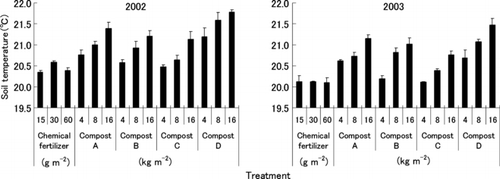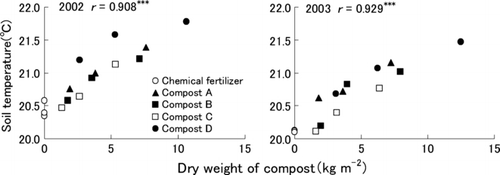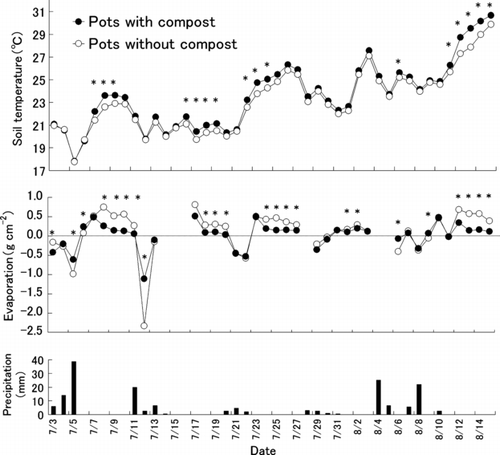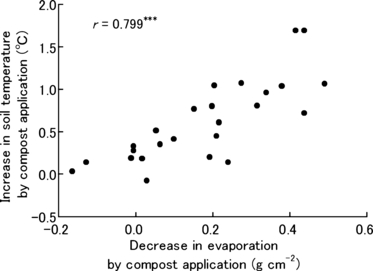Abstract
Soil temperature is an important factor influencing crop growth. Within limits, a higher soil temperature will promote crop growth, particularly in cool climates. The application of compost increases the soil temperature, probably by drying the soil surface, but the relationship between soil temperature and soil water remains unclear. We conducted pot and field experiments on a bare Andosol in a cool climate region. The pot experiment examined the effects of compost application on soil temperature and evaporation, and the field experiment examined the effects of the properties and amount of compost on soil temperature. Pots with compost had a higher soil temperature and less evaporation than pots without compost. The decrease in evaporation and the increase in soil temperature by compost application were significantly correlated. The field experiment included 15 treatments: 12 compost treatments (four types of compost × three levels) and three chemical fertilizer treatments (one type of fertilizer × three levels). There was a significant correlation between soil temperature and the dry weight of the applied compost. We conclude that compost application increases soil temperature by decreasing evaporation from the soil surface. In addition, soil temperature increases with increasing dry weight of the compost applied, regardless of the chemical properties.
Key words:
Introduction
Compost application is beneficial to crop growth, not only because it supplies nutrients, but also because it improves the physical and chemical properties of the soil (CitationBrady 1990). A number of researchers have reported that soil temperature is increased by the application of compost (CitationNaeini and Cook 2000; CitationSaito 1987). Increasing soil temperature, which promotes seed germination and nutrient availability, is expected to promote crop growth, particularly in cool climates. CitationSaito (1987) studied the effect of compost application on the temperatures of four soils and reported a much higher increase in soil temperature on Andosol than on alluvial or granitic soil. He speculated that the compost increases the temperature of the soil by drying the soil surface. However, the relationship between soil temperature and soil water remains unclear, and the effects of the properties and amount of compost applied require clarification.
The objectives of the present study were to clarify the relationship between increasing soil temperature and evaporation in pot experiments and to clarify the effects of the properties and amount of compost on soil temperature in field experiments on a bare Andosol in a cool climate region.
Materials and methods
Pot experiment
To establish the effects of compost application on soil temperature and evaporation from a bare soil, we conducted a pot experiment from July to August 2007 at the National Agricultural Research Center for Tohoku Region, Morioka, Japan (39°42′N, 141°09′E). Two treatments, pots with compost and pots without compost, were established, with three replicates each. Each pot had an upper area of 570 cm2 and a volume of 13 L. The pots were filled with a light clay (Pachic Melanudands; pH 5.8, total C 87.2 g kg−1, total N 6.3 g kg−1). Compost (compost A in ) was added at 0 or 16 kg m−2 (fresh weight) and mixed into the top 10 cm of the soil. The total weight of the added soil and compost was 12 kg per pot.
Bare ground measuring 3 m × 15 m was established in a field with a mesic soil temperature regime (CitationSoil Survey Staff 2003). Six empty pots were buried in the ground to accommodate the treatment pots. The soil level inside the pots was the same as that outside to minimize the effect of heat conduction through the sides. From 3 July to 15 August 2007, a temperature sensor set at a depth of 10 cm was used to record the soil temperature at 30-min intervals in each pot. The soil temperature data from 09.00 to 08.30 hours the next day were converted into 24-h average values for analysis. From 3–13 July, 18–27 July, 30 July to 3 August and 6–15 August, the weight of the inside pot was measured on an electronic balance at 09.00 hours every day. Daily evaporation from each pot was calculated from the difference in weight. On 6 and 15 August, soil was collected from seven layers (0–1, 1–2.5, 2.5–5, 5–7.5, 7.5–10, 10–15 and 15–20 cm) to measure the mass water content. To reduce the influence of this soil sampling on soil temperature and evaporation, the soil was collected away from the temperature sensor. On 15 August, the bulk density of the 0–5-cm layer was measured.
Field experiment
To establish the effects of the properties and amount of compost applied on the temperature of bare soil, we conducted a field experiment from 2002 to 2003 at the National Agricultural Research Center for the Tohoku Region. There were 15 treatments: 12 compost treatments (four types of compost () × three levels (4, 8 and 16 kg m−2 fresh weight) and three chemical fertilizer treatments (one type of fertilizer × three levels [N–P2O5–K2O = 15–15–15, 30–30–30 and 60–60–60 g m−2]). The chemical fertilizer contained ammonium sulfate, superphosphate and potassium chloride. To clarify the effect of the compost, the application rates were higher than the recommended rates. The experiment was arranged in a randomized block design with three blocks. Each plot measured 3 m × 3.6 m.
Table 1 Properties of the compost (average during the experiment)
Compost was applied on 9 April 2002 and on 10 April 2003. Immediately after application, the compost was incorporated to a depth of 10 cm by rotary tillage. On 14 May in both years, chemical fertilizer was applied and similarly incorporated. To suppress weed growth, herbicides (atrazine and metolachlor) were applied to all treatments. From 16 May to 15 September in both years, the soil temperature was measured as in the pot experiment. The data were averaged for analysis.
Results
Pot experiment
shows the soil temperature in the pots, the evaporation from the pots and the daily precipitation from 3 July to 15 August. Negative values of evaporation indicate that the weight of the pot increased with rainfall. Pots with compost had a higher soil temperature and less evaporation than pots without compost. To understand the relationship between evaporation and soil temperature, we plotted the differences in evaporation and soil temperature between the treatments (). There was a significant correlation between the decrease in evaporation and the increase in soil temperature with compost application. shows the vertical distribution of the mass water content in the pots on 6 and 15 August. The mass water content ranged between 0.4 and 0.5 kg kg−1 in all layers on 6 August in both treatments. In the pots with compost, the water content on 15 August decreased greatly only in the 0–1-cm layer; the deeper layers did not differ significantly between dates, except in the 7.5–10-cm layer. In contrast, in the pots without compost, the water contents were significantly lower on 15 August than on 6 August in all layers. The bulk density of the pots with compost was 49.7 g 100 mL−1, which was significantly lower (P < 0.05 by t-test) than the bulk density of the pots without compost (57.9 g 100 mL−1).
Field experiment
shows the soil temperatures in all treatments. Temperatures in the compost treatments were mostly higher than those in the chemical fertilizer treatments in both years. Moreover, the soil temperature increased with the amount of compost applied. Of note was the difference in soil temperature among the different types of compost applied at the same level: compost D most effectively increased soil temperature and compost C had the least effect. The soil temperature and dry weight of the compost were significantly correlated ().
Discussion
Evaporation obviously decreases when the soil surface becomes dry (CitationNaito et al. 1974). As a consequence, soil temperature increases (CitationKataoka et al. 1998; CitationMiyazawa and Konno 1976). CitationSaito (1987) speculated that the increase in soil temperature as a result of the application of compost originates in the drying of the soil surface. However, the relationship between soil temperature and soil water has not been clarified.
In the pot experiment, compost application decreased evaporation and increased the soil temperature (,). In the pots with compost, the soil water content on 15 August decreased compared with the content on 6 August only in the 0–1-cm layer, except in the 7.5–10-cm layer (). The latent heat of evaporation at the soil surface increases as evaporation increases, suppressing the rise of soil temperature. On 8 July, for example, evaporation from pots with and without compost was 0.26 and 0.75 g cm−2, respectively. If the air temperature then (21.4°C) is assumed to be the evaporation-side temperature, the latent heat of evaporation at the soil surface would have been 2435 J g−1. Therefore, the energy consumed by evaporation from pots with and without compost was 6.3 and 18.2 MJ m−2, respectively. Solar radiation on 8 July was 27.5 MJ m−2. Thus, 66% of the energy of solar radiation was lost by evaporation in the pots without compost, whereas only 23% was lost in the pots with compost. This difference in latent heat of evaporation between pots with and without compost influenced the soil temperature. Therefore, the main factor contributing to the increase in soil temperature with compost application was the decrease in the amount of water drawn from the deeper layers, which decreased evaporation. CitationUnger and Stewart (1974) reported that the evaporation reduction obtained by compost application results from the effects of the compost on bulk density and water retention. We found that compost application decreased bulk density and we assume that this was the reason for the decrease in evaporation from pots with compost. In contrast, CitationOlsen et al. (1970) reported that manure application increased the water repellency of soil, which decreases evaporation rates (CitationBachmann et al. 2001). Although we did not measure water repellency, it might partly explain the lower evaporation from the pots with compost.
Figure 3 Vertical distributions of the mass water contents in pots with and without compost on 6 and 15 August. *P < 0.05, **P < 0.01, ***P < 0.001 (t-test).

Figure 4 Average soil temperatures from 16 May to 15 September in field plots receiving various composts or fertilizer. Values are mean + standard error (n = 3).

Figure 5 Relationship between the dry weight of the applied compost and the average soil temperature from 16 May to 15 September. ***P < 0.001 (n = 15).

In the field experiment, we found a significant correlation between the dry weight of the compost applied and the soil temperature (). We attributed the increase in soil temperature with increasing amounts of applied compost to the decrease in evaporation from the soil surface; a similar result was found in a study with livestock waste (CitationUnger and Stewart 1974). We used four types of compost with different chemical properties (), but we found no significant correlation between the increase in soil temperature and these chemical properties. In other words, the soil temperature increased with the increasing dry weight of the compost applied, regardless of the chemical properties.
It is clear that the application of compost increased the soil temperature by decreasing evaporation from the soil surface, and that these effects increased with the amount of compost applied. Soil temperature markedly influences crop growth; for example, the initial growth of maize is promoted by soil temperature, reaching a maximum at 26°C (CitationWalker 1969). Therefore, compost application in early spring should increase the soil temperature, in turn promoting the initial growth of crops and expanding the cropping season in cool climate regions. In contrast, as the soil surface dries on account of organic matter application (CitationMatsumoto 1980), crop growth might be suppressed (CitationMatsuzaki et al. 1976). It is necessary to evaluate in detail the influence of increasing soil temperature by compost application on crop growth.
Acknowledgments
We thank Dr Masumi Okada, Dr Masanori Saito, Dr Keitaro Tawaraya and Dr Tsuneo Kondo for their useful suggestions on an early draft of this manuscript, Dr Masae Shiyomi for his statistical suggestions, and Mr Nobuyuki Yoshizawa, Mr Toshiyuki Sato and Mr Yoichi Kodate for technical assistance. This study was financially supported under the project “Development of a system for the production and distribution of high-quality beef from Japanese Shorthorn based on regional feed resources” by the Ministry of Agriculture, Forestry and Fisheries of Japan.
References
- Bachmann , J , Horton , R and van der Ploeg , R . 2001 . Isothermal and nonisothermal evaporation from four sandy soils of different water repellency . Soil Sci. Soc. Am. J. , 65 : 1599 – 1607 .
- Brady , NC . 1990 . “ Recycling nutrients through animal manures and other organic wastes ” . In The Nature and Properties of Soils , 497 – 516 . New York : Macmillan .
- Kataoka , K , Shiozawa , S and Tada , A . 1998 . Diurnal change of soil temperature and evaporation through dry layer in Tsukuba Kanto loam – Relationship between diurnal change of soil temperature and soil water content in a bare field (I) . Trans. Jpn. Soc. Irrig. Drain. Reclam. Eng. , 194 : 115 – 124 . (in Japanese with English summary)
- Matsumoto , Y . 1980 . Effect of the heavy application of hog feces to the surface dryness of Ando soil . Jpn. J. Soil Sci. Plant Nutr. , 51 : 175 – 178 . (in Japanese)
- Matsuzaki , T , Kagawa , Y and Uehara , K . 1976 . Studies on the physical changes of soil by application of large amounts of animal waste . J. Jpn. Soc. Soil Phys. , 33 : 3 – 10 . (in Japanese)
- Miyazawa , K and Konno , T . 1976 . Comparative studies of the moisture and thermal regimes on Andosol-Brown and Andosol-Black in Tokachi district . Res. Bull. Hokkaido Natl. Agric. Exp. Stn. , 114 : 89 – 118 . (in Japanese with English summary)
- Naeini , SAR and Cook , HF . 2000 . Influence of municipal waste compost amendment on soil water and evaporation . Commun. Soil Sci. Plant Anal. , 31 : 3147 – 3161 .
- Naito , Y , Kamota , F and Sakata , K . 1974 . Characteristics of consumptive use of water, irrigation method and water behavior in desiccated soil condition. II. Studies on the evaporation amount from soil surface and its prevention by mulching in various orchards . Rep. Coop. Res. Disaster Prevention , 34 : 61 – 73 . (in Japanese with English summary)
- Olsen , R , Hensler , R and Attoe , O . 1970 . Effect of manure application, aeration, and soil pH on soil nitrogen transformations and on certain soil test values . Soil Sci. Soc. Am. J. , 34 : 222 – 225 .
- Saito , M . 1987 . The rise of soil temperature due to heavy application of dairy cattle manure . Tohoku Agric. Res. , 40 : 177 – 178 . (in Japanese)
- Soil Survey Staff . 2003 . Keys to Soil Taxonomy , 9th edn , Washington, DC : USDA Natural Resources Conservation Service .
- Unger , PW and Stewart , BA . 1974 . Feedlot waste effects on soil conditions and water evaporation . Soil Sci. Soc. Am. J. , 38 : 954 – 957 .
- Walker , JM . 1969 . One-degree increments in soil temperatures affect maize seedling behavior . Soil Sci. Soc. Am. J. , 33 : 729 – 736 .

